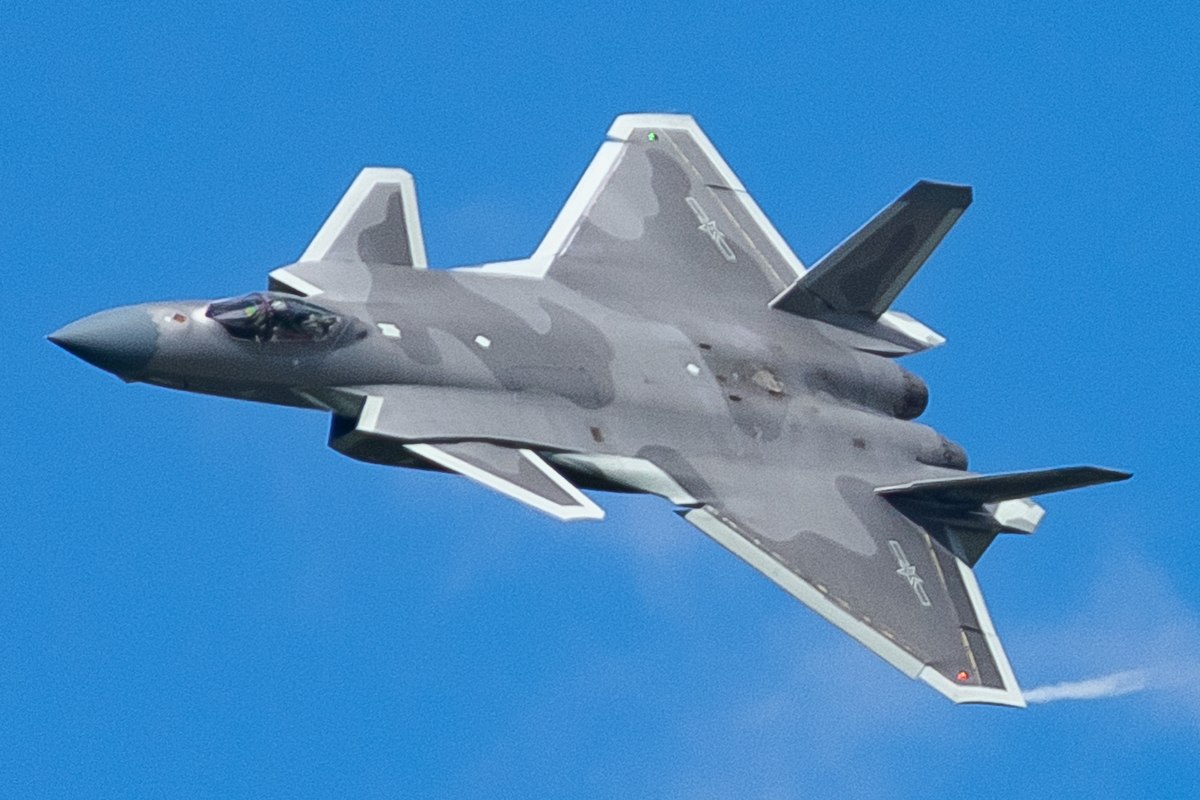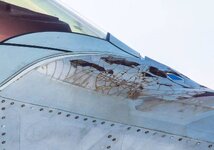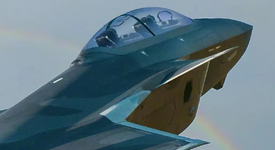Navigation
Install the app
How to install the app on iOS
Follow along with the video below to see how to install our site as a web app on your home screen.
Note: This feature may not be available in some browsers.
More options
You are using an out of date browser. It may not display this or other websites correctly.
You should upgrade or use an alternative browser.
You should upgrade or use an alternative browser.
Sukhoi Su-57
- Thread starter Admiral Beez
- Start date
Ad: This forum contains affiliate links to products on Amazon and eBay. More information in Terms and rules
More options
Who Replied?- Thread starter
- #82
Admiral Beez
Major
Two 5th gens I hope to see are the BAE Tempest and Mitsubishi F-X. Or are these sixth Gen?Good 4th gen on a good day, defo not 5th gen
- Thread starter
- #83
Admiral Beez
Major
FC-31 and J-20?
Good 4th gen on a good day, defo not 5th gen

China’s ‘Engine Problems’: Despite New Tech For J-20 Fighters, Beijing Remains Heavily Reliant On Russia -- US Experts
Russia’s war with Ukraine is likely to impact the Chinese military, especially its fighters jets, due to its over-dependence on Moscow. On May 17, experts at the China Aerospace Studies Institute conference predicted that Russia wouldn’t service or provide engines and components for up to 40% of...
 eurasiantimes.com
eurasiantimes.com
Jagdflieger
Senior Airman
- 580
- Mar 23, 2022
This article in the link is a paste copy article, originally dating from 2014. to 2015 to 2017......to 2022
China’s ‘Engine Problems’: Despite New Tech For J-20 Fighters, Beijing Remains Heavily Reliant On Russia -- US Experts
Russia’s war with Ukraine is likely to impact the Chinese military, especially its fighters jets, due to its over-dependence on Moscow. On May 17, experts at the China Aerospace Studies Institute conference predicted that Russia wouldn’t service or provide engines and components for up to 40% of...eurasiantimes.com
But what I like most is:
According to the Chinese state media – CCTV, the WS-15 seems to have a low bypass ratio and thrust vector control.
I like this photo:
Attachments
Last edited:
Jagdflieger
Senior Airman
- 580
- Mar 23, 2022
I like this one much more - the second pilot isn't a trainee, but responsible to pilot the "loyalty" wing-mansI like this photo:
Attachments
Some more photos (without "second pilot"):
View attachment 670742
View attachment 670743
View attachment 670744
That is an F-22 and there are no two seat F-22s anyhow.
Jagdflieger
Senior Airman
- 580
- Mar 23, 2022
That is an F-22 and there are no two seat F-22s anyhow.
- Thread starter
- #90
Admiral Beez
Major
Yep.That is an F-22 and there are no two seat F-22s anyhow.

These Images Of An F-22 Raptor's Crumbling Radar Absorbent Skin Are Fascinating
The photos are a reminder of just how much work goes into keeping the F-22's skin ready for combat and the amazing science behind its stealthy design.
Yep.

These Images Of An F-22 Raptor's Crumbling Radar Absorbent Skin Are Fascinating
The photos are a reminder of just how much work goes into keeping the F-22's skin ready for combat and the amazing science behind its stealthy design.www.thedrive.com
The article makes me laugh a lil…lol
FLYBOYJ
"THE GREAT GAZOO"
Hmmmm, let's see...
So we have some photos of the F-22 with RAM erosion which I'm sure was within limits or the aircraft wouldn't be flying. 195 F-22s built, 187 operational. Between September 2014 and July 2015, F-22s flew 204 sorties over Syria, dropping 270 bombs at some 60 locations.
Although the F-22 has a poor MC rate (a little over 50%) that still means there's about 92 of them operational at any given time...
Su-57, 15 built, 5 operational? first flight 2010. "Rumors" one was seen over Ukraine. I'm sure it's really making a difference.
So we have some photos of the F-22 with RAM erosion which I'm sure was within limits or the aircraft wouldn't be flying. 195 F-22s built, 187 operational. Between September 2014 and July 2015, F-22s flew 204 sorties over Syria, dropping 270 bombs at some 60 locations.
Although the F-22 has a poor MC rate (a little over 50%) that still means there's about 92 of them operational at any given time...
Su-57, 15 built, 5 operational? first flight 2010. "Rumors" one was seen over Ukraine. I'm sure it's really making a difference.
It's kinda old making comparisons between F-22s and Su-57s and J-20s, simply because there's one thing that the USA has that those countries, with the possible exception of China, don't have and that's money to deal with issues as they arise. The US leads the world in the size of its defence (or defense) budget. The US currently leads the world in arms supply to the rest of the world. These things mean something when it comes to R+D. They mean something when making comparisons between US and foreign military types.
The Russian defence budget is nowhere near as big as America's. The PAK-FA was supposed to be a family of stealth oriented aircraft, but the emphasis on stealth was not necessarily the sole driving factor behind the design of the Su-57. Yes, it had to incorporate stealth - it has RAM and passive stealth elements in its design, but the emphasis is on its radar signature from the front aspect only. It has been designed as a multirole strike fighter of advanced design and performance by using modern construction and avionics to remain competitive. In any other description it is an excellent fighter and the biggest fault of the aircraft lies not in its design but the political machine that produced it. It's too expensive for the Russian defence budget. Russian armed forces are falling behind technologically and modernisation is taking longer than expected because of the cost of doing so. This "Special Operation" in Ukraine can't be doing much to help, on the plus side however, what it is doing is revealing flaws in Russian military strategy and tactics, so the lesson is there for Russia to learn, but that's a different story for a different thread.
The J-20 is an impressive feat of engineering and to what degree its stealth elements work can only be hinted at. The Chinese are notoriously cagey about its capabilities, weapons fit, electronics etc, so little is known about this aircraft it's hard to make a credible assessment of it from a technology and capability perspective. We do know that the engines fitted to production examples are sub-standard (the trusty Lyulka Saturn) to what the Chinese are developing for it and we know that their intended powerplant (WS-15) is suffering teething troubles, but beyond that we can only surmise based on photographs and scraps of information that observers bring back from China. The wiki page is detailed without revealing a whole lot - read it carefully and it tells you a lot about its shape and characteristics, and there's a lot of "it could carry these missiles, it could have EOTS type sensors, it might have this performance" etc, but verifiable hard currency is few and far between.

 en.wikipedia.org
en.wikipedia.org
So, where does this leave us? That's up to the beholder. As someone who reads this stuff because I have to, it's a part of my aviation news reporting hat, I find the many comparisons between the jets found within the press meaningless in context. The aircraft are the products of the services that created them and their respective characteristics and being from environments with different aims and objectives, it's very difficult to make meaningful comparisons. I'll leave that to the armchair experts who write this stuff...
The Russian defence budget is nowhere near as big as America's. The PAK-FA was supposed to be a family of stealth oriented aircraft, but the emphasis on stealth was not necessarily the sole driving factor behind the design of the Su-57. Yes, it had to incorporate stealth - it has RAM and passive stealth elements in its design, but the emphasis is on its radar signature from the front aspect only. It has been designed as a multirole strike fighter of advanced design and performance by using modern construction and avionics to remain competitive. In any other description it is an excellent fighter and the biggest fault of the aircraft lies not in its design but the political machine that produced it. It's too expensive for the Russian defence budget. Russian armed forces are falling behind technologically and modernisation is taking longer than expected because of the cost of doing so. This "Special Operation" in Ukraine can't be doing much to help, on the plus side however, what it is doing is revealing flaws in Russian military strategy and tactics, so the lesson is there for Russia to learn, but that's a different story for a different thread.
The J-20 is an impressive feat of engineering and to what degree its stealth elements work can only be hinted at. The Chinese are notoriously cagey about its capabilities, weapons fit, electronics etc, so little is known about this aircraft it's hard to make a credible assessment of it from a technology and capability perspective. We do know that the engines fitted to production examples are sub-standard (the trusty Lyulka Saturn) to what the Chinese are developing for it and we know that their intended powerplant (WS-15) is suffering teething troubles, but beyond that we can only surmise based on photographs and scraps of information that observers bring back from China. The wiki page is detailed without revealing a whole lot - read it carefully and it tells you a lot about its shape and characteristics, and there's a lot of "it could carry these missiles, it could have EOTS type sensors, it might have this performance" etc, but verifiable hard currency is few and far between.

Chengdu J-20 - Wikipedia
So, where does this leave us? That's up to the beholder. As someone who reads this stuff because I have to, it's a part of my aviation news reporting hat, I find the many comparisons between the jets found within the press meaningless in context. The aircraft are the products of the services that created them and their respective characteristics and being from environments with different aims and objectives, it's very difficult to make meaningful comparisons. I'll leave that to the armchair experts who write this stuff...
Theres 2 less, Maverick shot them downHmmmm, let's see...
So we have some photos of the F-22 with RAM erosion which I'm sure was within limits or the aircraft wouldn't be flying. 195 F-22s built, 187 operational. Between September 2014 and July 2015, F-22s flew 204 sorties over Syria, dropping 270 bombs at some 60 locations.
Although the F-22 has a poor MC rate (a little over 50%) that still means there's about 92 of them operational at any given time...
Su-57, 15 built, 5 operational? first flight 2010. "Rumors" one was seen over Ukraine. I'm sure it's really making a difference.
- Thread starter
- #96
Admiral Beez
Major
I think we forget just how small the Russian economy and GDP is. My thinly populated country, Canada is eighth in nominal GDP. With more than 3.5X the population, Russia is eleventh. Russia spends over 4% of that GDP on its military, and has shoddy results to show for itself.The Russian defence budget is nowhere near as big as America's.
Canada spends less than 1.5% of its GDP on military. Imagine what Canada's military would look like if we spent 4%. A far sight better than Russia's I hope. 150 x F-35s, a dozen new Type 26 frigates, two Canberra-class LHDs, six AIP SSKs and two squadrons of long distance arctic recon drones would be a nice start.
Last edited:
Jabberwocky
Tech Sergeant
We do know that the engines fitted to production examples are sub-standard (the trusty Lyulka Saturn) to what the Chinese are developing for it and we know that their intended powerplant (WS-15) is suffering teething troubles,
More than just teething problems.
WS-15 development has been ongoing for better than 20 years, during which time it has (publically at least) undergone two sets of substantial redesigns. The engine definitely failed qualification testing in 2019 and likely did again so in late 2021.
As of March this year, I believe there was one engine undergoing flying testing on a modified Y-20 and maybe 10 undergoing bench or ground testing. EDIT: There's unconfirmed reports of a J-20 undergoing testing with a single WS-15 as well, no indication whether these are flight or ground tests though.
Chinese state media is suggesting the WS-15 would be 'mature' enough for deployment in 2024. However, the engine has been "one to two years away" since about 2015, so don't hold your breath.
China has successfully gotten a handful of prototype engines working to specification (delivering 16 to 18 tonnes of thrust), but even the limited pre-production examples are a different story. The single-crystal style fan blades are (still) repeatedly failing below max design loads, to the point where in 2021 there was talk of completely revising the materials used. There was another 2021 report that the pre-production engines were giving only 14 tonnes of thrust, attributed to issues with the 2007-2008 redesign of the engine's hot section.
It's one thing to hit design goals with a prototype. It's another thing entirely to mature that engine to the point where it can hit the same targets in service.
Last edited:
- Thread starter
- #99
Admiral Beez
Major
Why's it so smokey? It's like a 1960s Phantom II.


SaparotRob
Unter Gemeine Geschwader Murmeltier XIII
Imitation is the sincerest form of flattery.
Users who are viewing this thread
Total: 1 (members: 0, guests: 1)
Similar threads
- Replies
- 0
- Views
- 611
- Replies
- 6
- Views
- 2K


